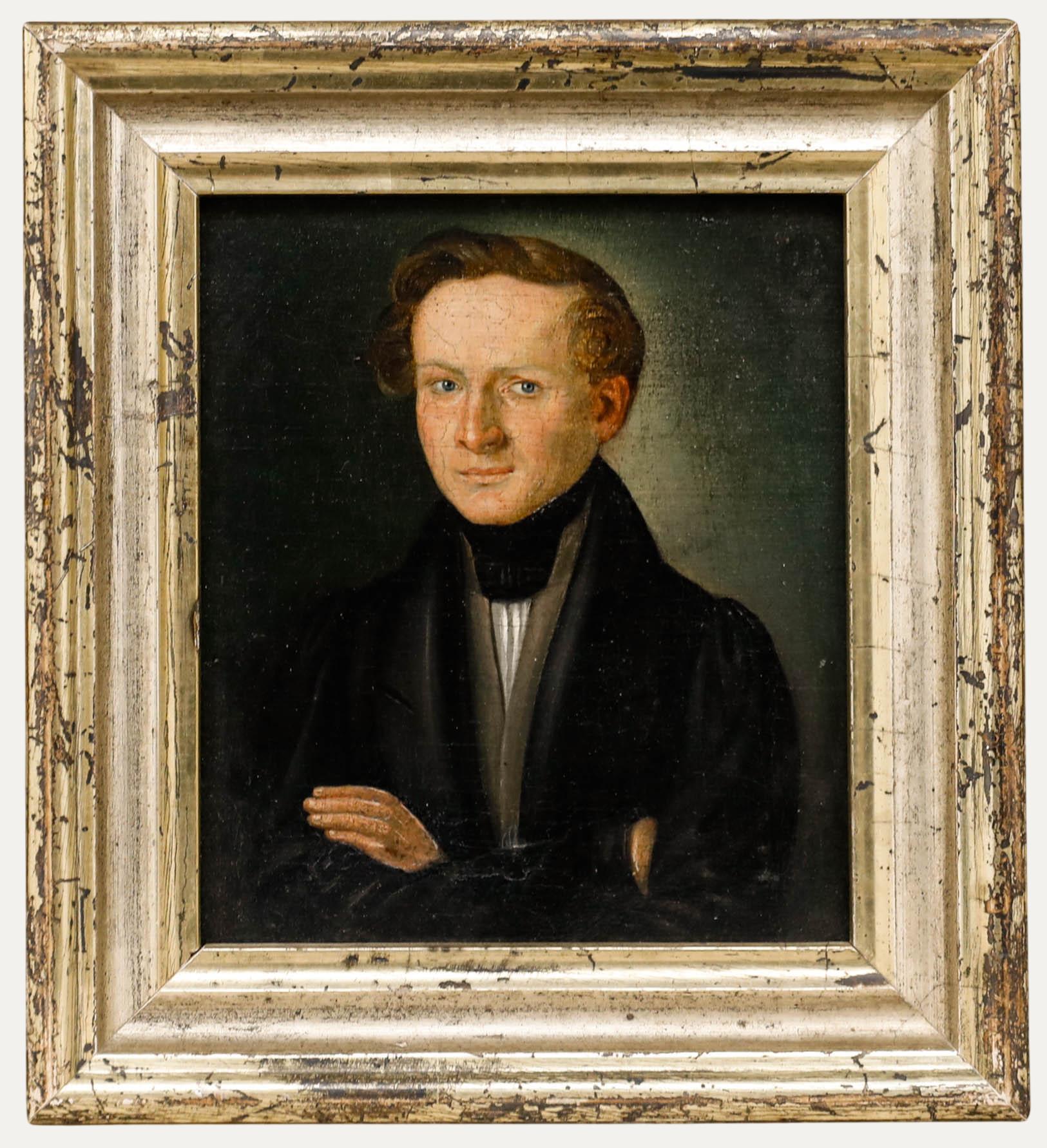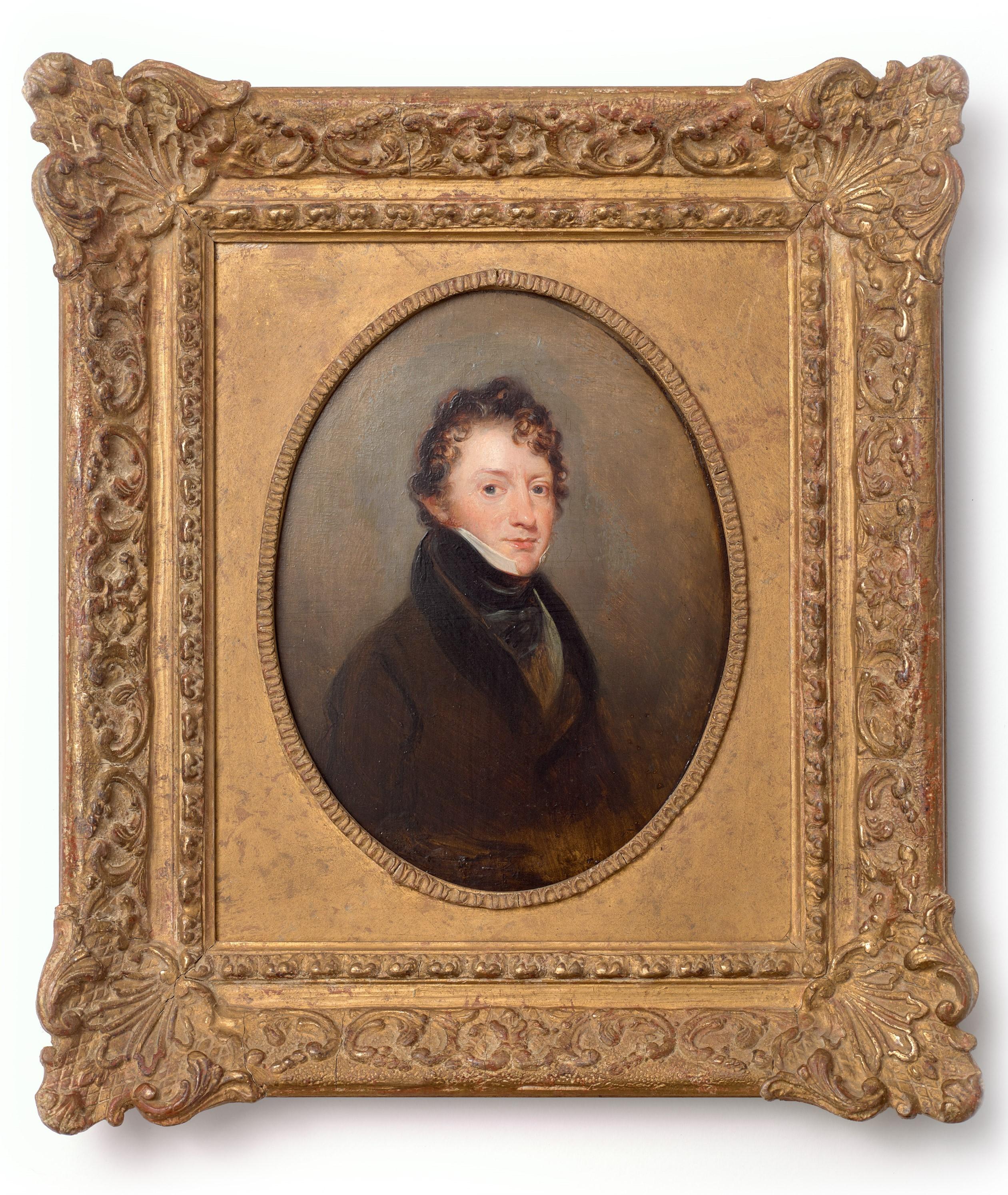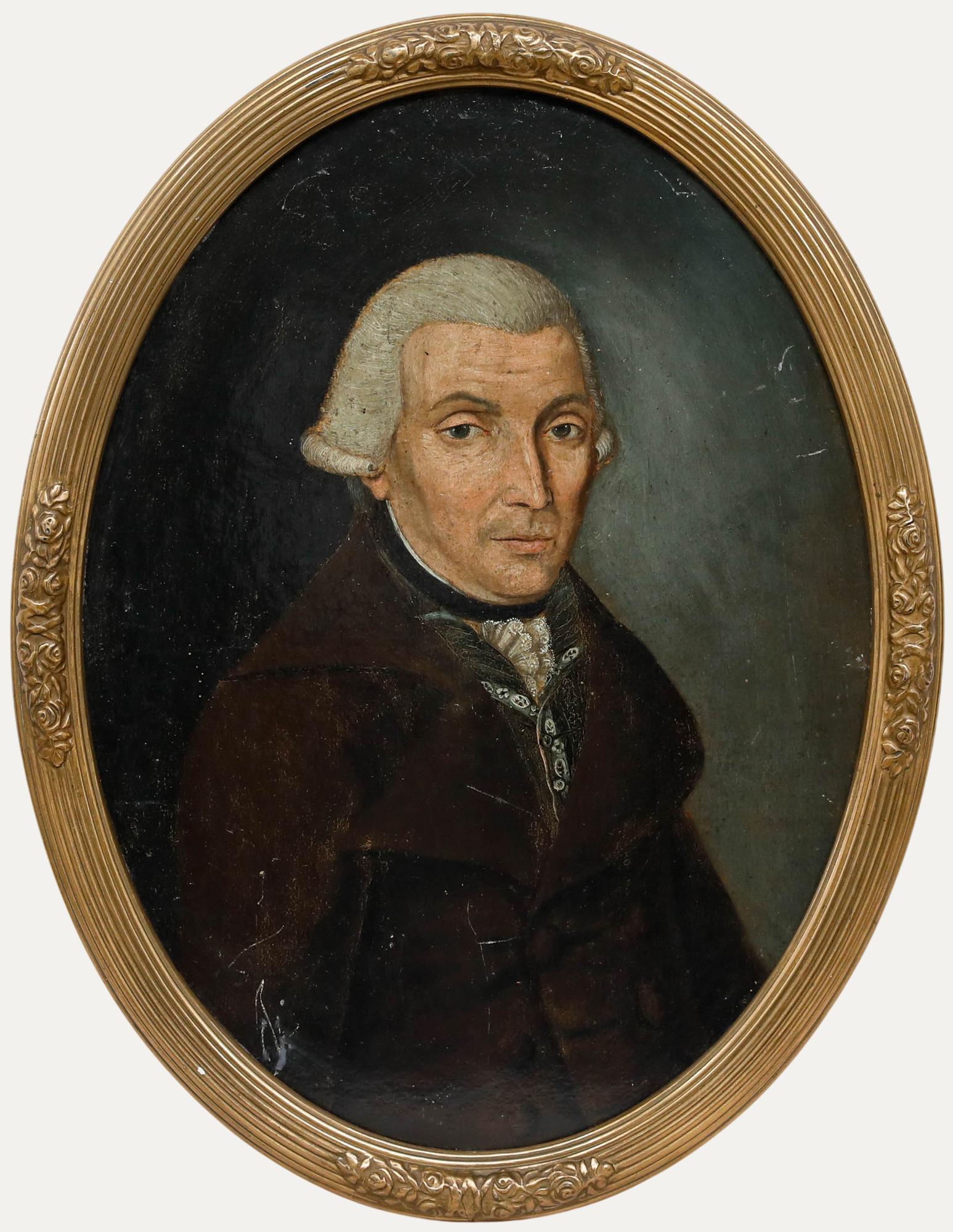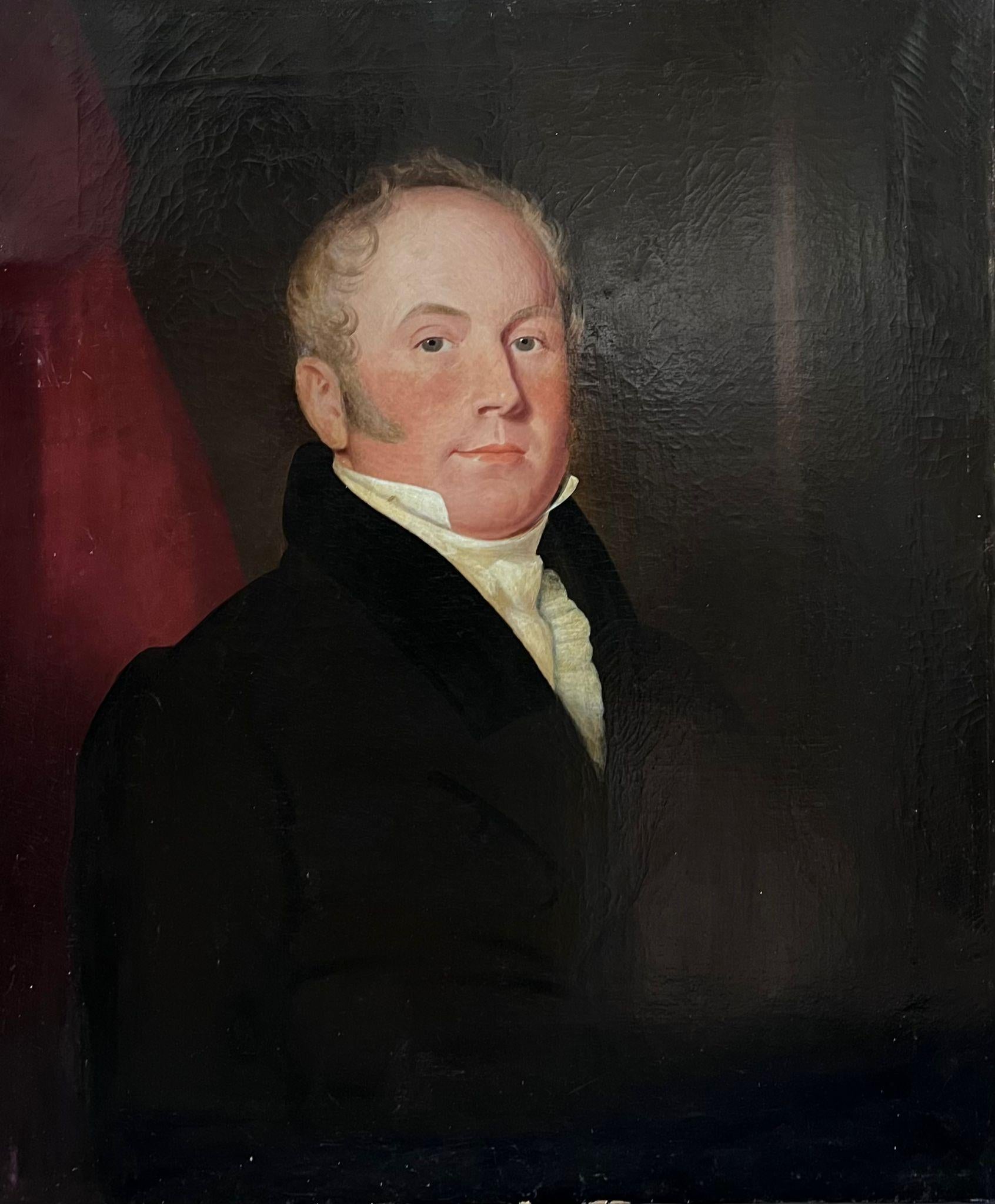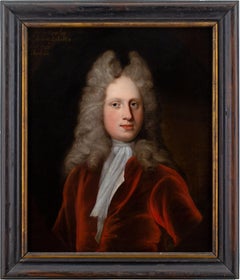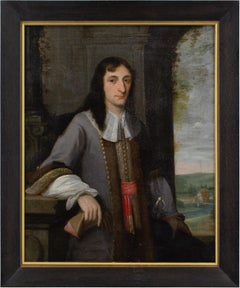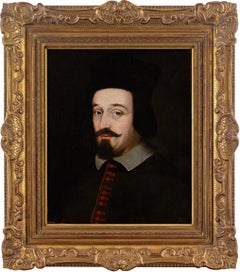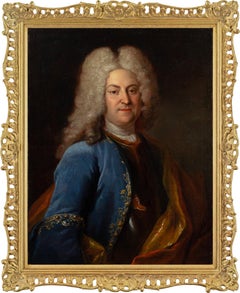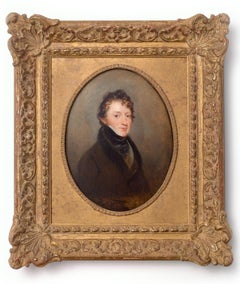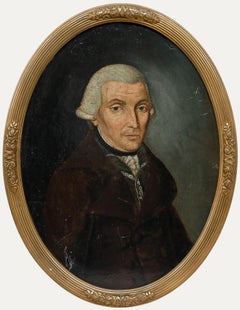Items Similar to Mid-19thC English School Portrait Of A Gentleman With Magnifying Glass, Oil
Want more images or videos?
Request additional images or videos from the seller
1 of 12
John Robert WildmanMid-19thC English School Portrait Of A Gentleman With Magnifying Glass, Oilc. 1840
c. 1840
$1,229.09
£900
€1,047.66
CA$1,693.29
A$1,845.39
CHF 977.21
MX$22,165.08
NOK 12,371.74
SEK 11,374.60
DKK 7,824.82
About the Item
This charming mid-19th-century oil painting by British artist John Robert Wildman (1788-1843) depicts a gentleman wearing a dark brown frock coat with waistcoat, white shirt and cravat.
Calm, intelligent, and burdened by the rigours of early Victorian England, he holds our attention. Simply a man, his thoughts, and a magnifying glass. Watchmaker, physician or philosopher, maybe? A ponderer of life’s minutiae, amid an ever-evolving industrious society. Wildman has translated his character via sculptural brushwork, which is rendered in the darker areas with subtle modulations. He’s worked quickly, retaining a sense of the sitter’s spirit, while conveying the play of light with assured, expressive marks.
Born in Lambeth, London, Wildman was initially trained by his father but little else is known about how he developed such a keen reputation as a portraitist. During the 1820s, he rose to prominence when producing numerous works depicting the notable figures of his day. Many of these were engraved for various publishers and disseminated widely.
Around 1820, he produced a scene featuring the Yorkshire landowner, and member of parliament, Walter Fawkes accompanied by a rather stout J.M.W. Turner in the grounds at Farnley Hall. How he came to paint them is unclear but he certainly moved within the right circles.
Following his debut at the Royal Academy, British Institution and Society of British Artists, he continued to work from his London studio, living first in Mile End and later at Beaumont Square in Stepney with his wife and five children. All was apparently well and in 1841, a Royal commission followed when Prince Albert sat for him.
However, the following year, his wife Elizabeth died prematurely leaving him to raise his family single-handed. And to compound his distress, he had become seriously unwell, resulting in a near-total loss of income. The Art Union published a plea in the hope of attracting an act of philanthropy, but to little avail - in 1843, he died of “general debility”.
“Mr. John Robert Wildman, a Portrait Painter of considerable talents, has been suffering from illness so severe for the last two years, as to render him utterly incapable of pursuing his profession; his means of subsistence are entirely exhausted; he has a young family entirely dependant on him for support, and has had the misfortune recently to lose his wife by sudden death. Subscriptions will be thankfully received, and specimens of his works shown, by Messrs. Welch and Gwynne, 24, St. James's Street, Printsellers to the Royal Family.”
The life and trials of John Robert Wildman serve as a poignant reminder of the fate of many early 19th-century painters who, despite their evident skill and reputation, were consumed by the realities of their environment. He remains underrated.
Signed/inscribed on the reverse and held within a later frame.
Labels & Inscriptions: Inscribed on the reverse.
Provenance: Private collection, UK.
Artist’s auction maximum: £12,650 for ‘Portrait of a Young Girl’, Oil on canvas, Christie’s, Old Master Paintings, New York, 1995 (lot 85).
- Creator:John Robert Wildman (1788 - 1843, British, English)
- Creation Year:c. 1840
- Dimensions:Height: 35.5 in (90.17 cm)Width: 30.5 in (77.47 cm)
- Medium:
- Period:
- Condition:Cleaned. Revarnished. Canvas relined. Craquelure throughout. The paint layer is stable. Old repairs. Frame in excellent condition.
- Gallery Location:Cheltenham, GB
- Reference Number:1stDibs: LU2328215315612
About the Seller
5.0
Gold Seller
Premium sellers maintaining a 4.3+ rating and 24-hour response times
Established in 2017
1stDibs seller since 2023
250 sales on 1stDibs
Typical response time: 1 hour
- ShippingRetrieving quote...Shipping from: Cheltenham, United Kingdom
- Return Policy
More From This Seller
View All18thC English School Gentleman In A Red Velvet Coat, Oil On Canvas, Portrait
Located in Cheltenham, GB
US buyers pay no import tariffs on this painting.
This early 18th-century English School portrait depicts Thomas Stanley wearing a striking red velvet suit, white cravat and powdere...
Category
Early 18th Century English School Portrait Paintings
Materials
Canvas, Oil
17th-Century Flemish School, Portrait Of A Gentleman In A Justaucorps, Oil
Located in Cheltenham, GB
This fine late 17th-century Flemish portrait depicts a distinguished gentleman wearing a justaucorps, black cloak, white shirt, vest, leather gloves, and breeches. He’s carrying a wi...
Category
1670s Old Masters Portrait Paintings
Materials
Canvas, Oil
Mid-17th-Century Spanish School Oil Painting, Portrait Of A Theologian
Located in Cheltenham, GB
This mid-17th-century Spanish oil on canvas depicts a dignified man of learning - a theologian, or perhaps a cathedral canon.
Dressed in a black cassock, marked by a vertical row of...
Category
Mid-17th Century Baroque Portrait Paintings
Materials
Canvas, Oil
Early 18th-Century French Rococo Oil Painting, Portrait of a Baron
Located in Cheltenham, GB
This sumptuous early 18th-century portrait by leading French artist Louis de Silvestre (1675-1760) depicts Baron Pierre de Gaultier, a nobleman and diplomat active during the final y...
Category
Early 18th Century Rococo Portrait Paintings
Materials
Canvas, Oil
Mid-18th-Century German School, Portrait Of An Aristocrat In Armour, Oil
Located in Cheltenham, GB
This mid-18th-century half-length German portrait depicts a middle-aged aristocrat wearing armour and a wig.
Despite his heavily-clad appearance, it’s likely that this rather noncha...
Category
1750s Old Masters Portrait Paintings
Materials
Oil, Canvas
Early 17th-Century Dutch School, Portrait Of A Swedish Officer, Oil Painting
Located in Cheltenham, GB
This heavily-inscribed early 17th-century half-length portrait depicts an officer wearing a silk doublet with a gorget, presented in a feigned oval. He’s standing alongside an anchor...
Category
17th Century Baroque Portrait Paintings
Materials
Canvas, Oil
You May Also Like
Fine Early 19th Century Oil - Portrait of a Discerning Gentleman
Located in Corsham, GB
A fine Biedermeier-era portrait depicting a sharply dressed gentleman with arms confidently crossed as he meets the viewer with a discerning expression. The composition is both intim...
Category
Early 19th Century Portrait Paintings
Materials
Oil
Portrait of John Manners later 7th Duke of Rutland
By Margaret Sarah Carpenter
Located in Douglas, Isle of Man
Margaret Sarah Carpenter 1793-1872, was an English portrait painter. She was one of the foremost portrait painters in the 19th Century, she ex...
Category
1830s Portrait Paintings
Materials
Oil, Panel
Early 19th Century Oil - Portrait of a Gentleman
Located in Corsham, GB
A formal portrait of a gentleman wearing a brown coat and wig. Well presented in an oval gilt-effect frame with floral ornamentation. Illegibly inscribed in German to the reverse of ...
Category
Early 19th Century Portrait Paintings
Materials
Oil
Portrait of a man
By Antoine Jean Gros
Located in Paris, IDF
French school from the beginning of the 19th century
Three-quarter bust portrait of a man
Oil on panel
28 x 21 cm
Circa 1820
This portrait of a man, typical of the French school o...
Category
Early 19th Century French School Portrait Paintings
Materials
Oil
Portrait of William Cooper - British Victorian art male portrait oil painting
By Thomas Lawrence
Located in Hagley, England
This superb Victorian portrait oil painting is attributed to circle of Thomas Lawrence. Painted circa 1836 the sitter is William Henry Cooper, of Pains Hill, Cobham, Surrey and Hig...
Category
1830s Victorian Portrait Paintings
Materials
Oil
$9,286 Sale Price
20% Off
19th Century English Victorian Oil Painting on Canvas Portrait of a Gentleman
Located in Cirencester, Gloucestershire
Portrait of an English Gentleman
English artist, 19th century
oil on canvas, unframed
Canvas: 30.5 x 25 inches
Provenance: Private collection, England
Condition: overall very good an...
Category
19th Century Victorian Portrait Paintings
Materials
Oil, Canvas
More Ways To Browse
Antique Gentleman
Royal Prince
1849 Painting
J M W Turner Paintings
Antique Prince Albert
Antique White Shirt
19Th Century Reverse Glass Paintings
Antique Magnifying Glasses
19th Century Reverse Painting On Glass
Hang Coat
Antique Cravat
Antique Frock Coat
Old Master Pastel Portraits
Portrait Man Turban
Portrait Of A Bride
Portrait Of A Cardinal
Sir William Beechey
Society Lady Painting
